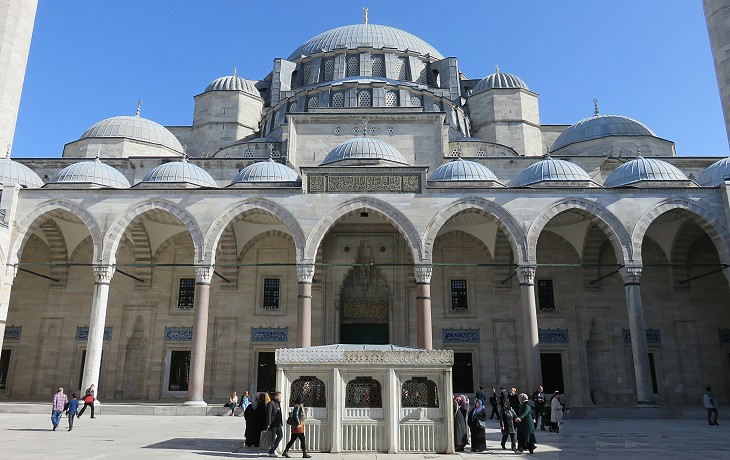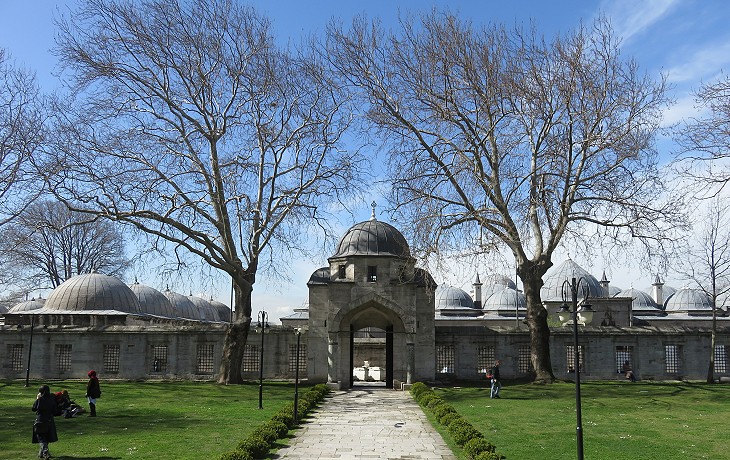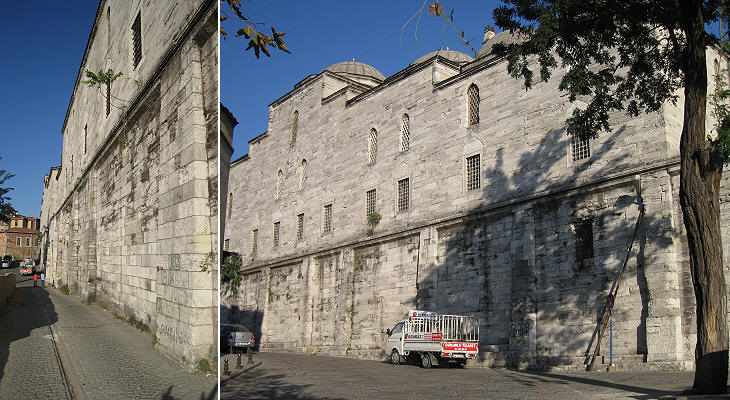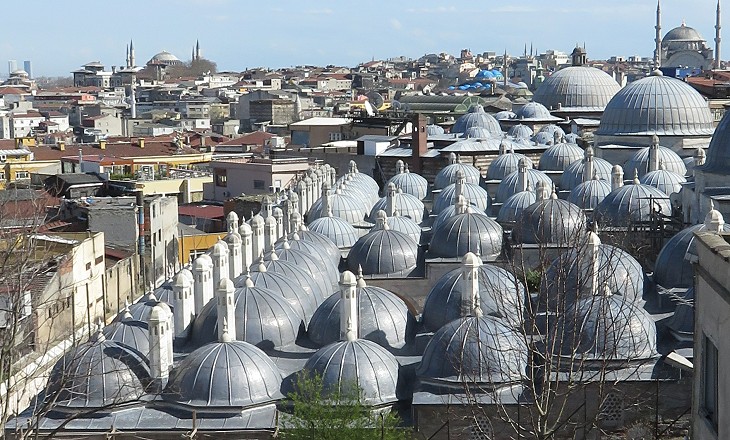  What's New! Detailed Sitemap All images © by Roberto Piperno, owner of the domain. Write to romapip@quipo.it. Text edited by Rosamie Moore. Page revised in August 2015. |
  The Golden Century: III - Suleymaniye Kulliye The Golden Century: III - Suleymaniye Kulliye
You may wish to see an introductory page to this section first. The long reign of Sultan Suleyman (1520-66) was characterized by a significant growth in the population of the Ottoman Empire; this led to the migration of peasants to the cities, chiefly to Constantinople, thus causing a problem of urban unemployment. Trade activities and the large number of jobs related to the administration of the state and to the court were not sufficient to provide an occupation for all the inhabitants and especially for the less skilled ones. The construction of Suleymaniye, as well as of many other mosques, was a way to control the masses and prevent them from turning against their rulers.
In 1535 Sultan Suleyman commissioned the Venetian goldsmiths a headdress similar to the papal three-tiered crown, but with four crowns; they indicated that the Sultan was the lord of both the East and the West, both in land and at sea. It was also an indication that he regarded himself as the ultimate sovereign. It appears he did not wear this headdress, but kept it next to him during audiences. In a peace treaty Suleyman signed with Charles V in 1547 he obtained that the latter did not use the title of "Emperor" in the wording of the treaty.
The construction of the mosque required just seven years and the vast number of ancillary buildings were completed subsequently. This shows the reliability of the financial and logistic systems which supported the accomplishment of such a large enterprise. Suleyman did not spend all his time leading his armies or being absorbed by family quarrels, he also strengthened the administrative and judiciary systems of his empire. Mimar Sinan, who was entrusted with the design and the actual construction of Suleymaniye, could rely on a steady flow of funds, whereas in Rome the completion of St. Peter's required almost a century.
In order to build the complex on a flat level Sinan had to create a large artificial terrace at the top of the Third Hill; the terrace however is larger than the mosque only to the south of the latter, where there is space for a large alley.
The complex of Suleymaniye was not only directed to impress the western world, but it had a political purpose in legitimizing the Sultan in the eyes of the Islamic world. With the conquest of Egypt at the beginning of the century and the later expansion of the Ottoman Empire along the shores of northern Africa and of the Red Sea, the number of Muslim subjects increased in a very significant manner. The other main Muslim power was that of Persia; the two empires were not divided only by historical and ethnical differences, but also by a religious one: the Shah of Persia was the champion of Shia Islam and therefore Suleyman decided to stress his role of leader of Sunni (Orthodox) Muslims. This policy was meant to counterbalance the Persian allegations that Ottoman sultans were dominated by (former) Christian wives and mothers. He formally adopted the title of Caliph, which meant leader of the Islamic world.
The construction of Suleymaniye was meant to celebrate in stone the sultan's status at a time when western Europe was torn apart by religious conflicts. The four minarets were meant to represent that Suleyman was the fourth sultan to rule in Constantinople and their ten serefes (balconies) that he was the tenth sultan of the House of Osman, the founder of the Ottoman dynasty.
According to tradition Sultan Mehmet II, the Conqueror of Constantinople, executed the architect of his mosque on the Fourth Hill because its dome was not as large as that of Hagia Sophia (108ft wide). The dome of Suleymaniye is 90ft, but it seems larger because its view is not impaired by the buttresses which were added to the dome of Hagia Sophia in order to prevent its collapse. It has become the landmark of the city seen from the Golden Horn.
The size of the dome is somewhat diminished by that of the courtyard and in particular by the height of its arches. Sinan could use some ancient columns for them; four pink granite columns were placed at the sides of the entrance.
The interior is marked on the northern and southern sides by three arches supported by gigantic monolithic columns; above them there is a vaulted tympanum filled with windows which give a lot of light to the main hall.
We hardly considered it (Hagia Sophia) more worth visiting than some of the other mosques of Constantinople; for example the superb Mosque of Sultan Solyman (which) may fairly vie with the boasted chef-d'oeuvre of Anthemius of Tralles (the architect of S Hagia Sophia). Edward Daniel Clarke - Travels in various Countries of Europe, Asia and Africa - 1810. Not many travellers of the past actually visited the interior of mosques, in part because a firman (special permit) was required. From their accounts we know that floors were covered with a jumble of mats and carpets. The interior of Suleymaniye Camii was recently embellished with a floor carpet based on the multiple niche carpets (it opens in another window) which were made at Usak in the XVIIth century. It helped believers to distribute themselves inside the mosque in an orderly manner.
The decoration of the interior, apart from a limited use of tiles and wooden inlays, was mainly based on the elaborate inscriptions of Ahmed Karahisari (i.e. from Afyonkarahisar), one of the most celebrated Ottoman calligraphers.
Each Friday Suleyman prayed at the mosque; he was preceded by the Janissaries, the clergy, the four grand viziers at the head of the administration and he was followed by his retinue. Suleyman mounted a horse caparisoned in velvet and carried a scimitar decorated with emeralds and diamonds.
The western side of the kulliye housed a caravanserai, an imaret (soup kitchen) and a darussifah (hospital). Because of the sloping ground these buildings were strengthened with buttresses. The soup kitchen and the hospital showed the piety of Suleyman towards the poor, because they could access these facilities without paying.
A very large imaret provided food to the poor of the neighbourhood and to the large number of people gravitating around Suleymaniye; the clergy of the mosque, the students of the medrese, the staff and patients of the hospital, the travellers at the caravanserai. Usually the menu was based on barley soup, bread and a bowl of rice.
Two medrese were built on the southern flat side of the terrace and two on the sloping ground to the north of the mosque. The latter with their arrays of small domes can be best seen from a coffee-shop on the roof of a nearby modern building.
Suleyman was buried in a turbe designed by Sinan which is located behind the mosque; its design resembles a small Dome of the Rock, the Jerusalem mosque built on the site of Solomon's temple, because of the ambulatory surrounding the building. Mihrimah, Suleyman's daughter and a very influential advisor to him, chose to be buried inside this turbe, rather than next to her mother, her husband or her son.
Haseki Hurrem (Roxelana), Suleyman's wife was buried in a turbe next to that of her husband; her pious activities are described in a long inscription below the dome. Yet his memory is not due to the charities she founded, but to the love she inspired in Suleyman. Luigi Bassano, a Venetian from Zara who spent his youth in Constantinople wrote: Suleyman le porta tal’amore che fa meravigliare tutti i suoi sudditi, in tanto che dicono ch’ella l’ha ammaliato, perche la chiamano Ziadi, che vuol dir Strega (bears her such love and keeps such faith to her that all his subjects marvel and say that she has bewitched him, and they call her Ziadi, which means witch).
Sinan did not regard Suleymaniye as his masterpiece which he thought was the later complex he built at Edirne for Sultan Selim II, Suleyman's successor. He chose however to be buried in a small turbe near Suleymaniye; Mustafa Sai Celebi, his poet/painter friend, dictated an inscription which describes Suleymaniye as a symbol of paradise.
The image used as background for this page shows a detail of the interior of Suleymaniye. Introduction to this section Roman Memories Hagia Sophia Byzantine Heritage (before 1204) Hagia Irene and Little Hagia Sophia Roman/Byzantine exhibits at the Archaeological Museum Great Palace Mosaic Museum St. Saviour in Chora Byzantine Heritage (between 1204 and 1453) First Ottoman Buildings The Golden Century: I - from Sultan Selim to Sinan's Early Works The Golden Century: II - The Age of Suleyman The Golden Century: IV - Sinan's Last Works The Heirs of Sinan Towards the Tulip Era Baroque Istanbul The End of the Ottoman Empire Topkapi Sarayi Museums near Topkapi Sarayi The Princes' Islands Map of Istanbul Other sections dealing with Constantinople/Istanbul: The Walls of Nova Roma Galata Clickable Map of Turkey showing all the locations covered in this website (opens in another window). |

















